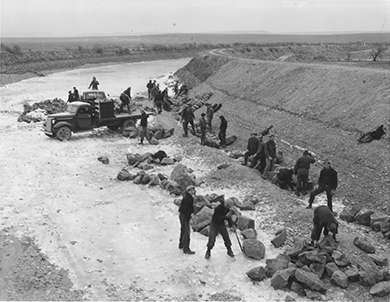| << Chapter < Page | Chapter >> Page > |
In his first hundred days in office, the new president pushed forward an unprecedented number of new bills, all geared towards stabilizing the economy, providing relief to individuals, creating jobs, and helping businesses. A sympathetic Democrat-controlled Congress helped propel his agenda forward.
Even as he worked to rebuild the economy, Roosevelt recognized that the unemployed millions required jobs more quickly than the economy could provide. In a push to create new jobs, Roosevelt signed the Wagner-Peyser Act, creating the United States Employment Service, which promised states matching funds if they created local employment opportunities. He also authorized $500 million in direct grants through the Federal Emergency Relief Act (FERA). This money went directly to states to infuse relief agencies with the much-needed resources to help the nearly fifteen million unemployed. These two bills illustrate Roosevelt’s dual purposes of providing short-term emergency help and building employment opportunities that would strengthen the economy in the long term.
Roosevelt was aware of the need for immediate help, but he mostly wanted to create more jobs. FERA overseer Harry Hopkins, who later was in charge of the Civil Works Administration (CWA), shared this sentiment. With Hopkins at its helm, the CWA, founded in early 1933, went on to put millions of men and women to work. At its peak, there were some four million Americans repairing bridges, building roads and airports, and undertaking other public projects. Another work program was the Civilian Conservation Corps Relief Act (CCC). The CCC provided government jobs for young men aged fourteen to twenty-four who came from relief families. They would earn thirty dollars per month planting trees, fighting forest fires, and refurbishing historic sites and parks, building an infrastructure that families would continue to enjoy for generations to come. Within the first two months, the CCC employed its first 250,000 men and eventually established about twenty-five hundred camps ( [link] ).

The various programs that made up the First New Deal are listed in the table below ( [link] ).
| New Deal Legislation | Years Enacted | Brief Description |
|---|---|---|
| Agricultural Adjustment Administration | 1933–1935 | Farm program designed to raise process by curtailing production |
| Civil Works Administration | 1933–1934 | Temporary job relief program |
| Civilian Conservation Corps | 1933–1942 | Employed young men to work in rural areas |
| Farm Credit Administration | 1933-today | Low interest mortgages for farm owners |
| Federal Deposit Insurance Corporation | 1933–today | Insure private bank deposits |
| Federal Emergency Relief Act | 1933 | Direct monetary relief to poor unemployed Americans |
| Glass-Steagall Act | 1933 | Regulate investment banking |
| Homeowners Loan Corporation | 1933–1951 | Government mortgages that allowed people to keep their homes |
| Indian Reorganization Act | 1933 | Abandoned federal policy of assimilation |
| National Recovery Administration | 1933–1935 | Industries agree to codes of fair practice to set price, wage, production levels |
| Public Works Administration | 1933–1938 | Large public works projects |
| Resettlement Administration | 1933–1935 | Resettles poor tenant farmers |
| Securities Act of 1933 | 1933–today | Created SEC; regulates stock transactions |
| Tennessee Valley Authority | 1933–today | Regional development program; brought electrification to the valley |

Notification Switch
Would you like to follow the 'U.s. history' conversation and receive update notifications?